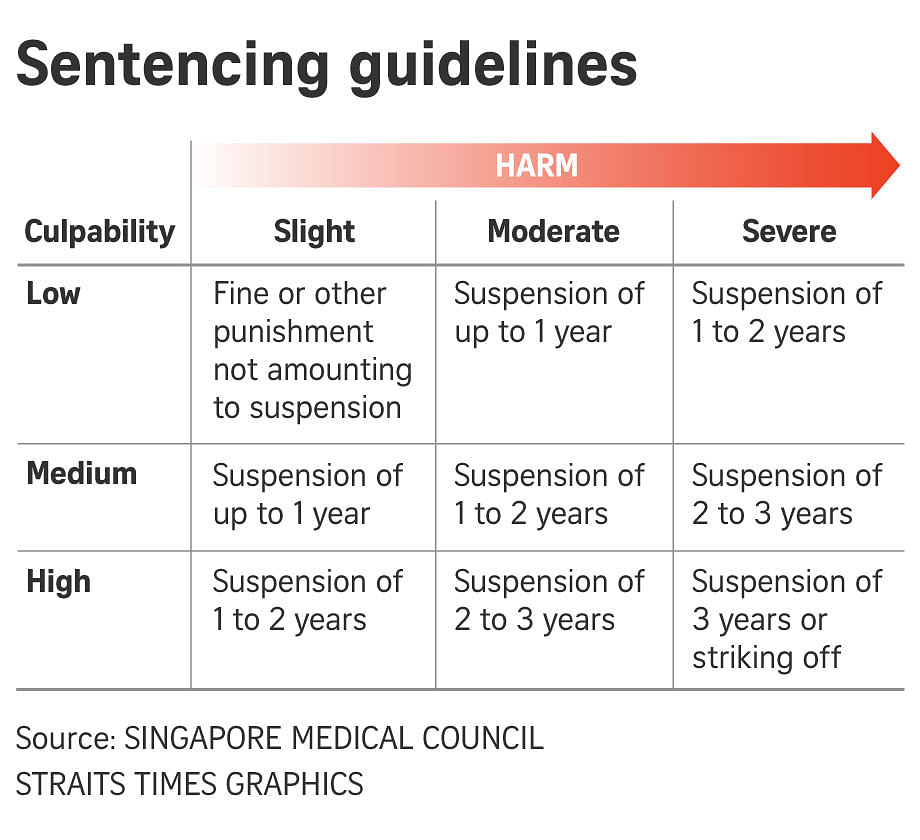SINGAPORE - The committee headed by Justice Judith Prakash issued sentencing guidelines on Wednesday (July 15) to help the medical profession "arrive at fair and consistent sentencing decisions", said the Singapore Medical Council (SMC).
It added: "This will contribute to the desired outcome of upholding the standards of medical practice, and maintaining the confidence and trust of both the public and the medical profession in the medical disciplinary process."
The committee was one of two set up last year to improve the SMC's disciplinary process. It comprised four lawyers, six doctors and a representative each from the ministries of health and law.
The second committee is to help speed up disciplinary processes.
The SMC is the medical watchdog and metes out punishment to errant doctors. Its disciplinary tribunals (DTs) usually comprise two doctors and a third member, who may be a lay person or a legally trained person.
Explaining the need for the two committees, Health Minister Gan Kim Yong told Parliament in April last year that there had been some unfair penalties by the DTs.
Mr Gan said: "Some sentences are not commensurate with the circumstances of the case.
"Despite their best efforts, some DTs are too lax, while others are too draconian, and the SMC has had to appeal to the court against the sentences meted out."
Quite a number of DT judgments had been overturned by the Court of Three Judges on appeal by one or both of the parties involved.
The 54-page guidelines explain when tribunals need to mete out more severe penalties and when they should be lighter. It gives some real examples as references.
When a doctor is found guilty by a tribunal, sentencing options range from counselling, censure and fines to suspension or even striking the doctor's name off the medical register, which means he can no longer practise.

These are the objectives when sentencing a doctor for wrongdoing:
- Uphold people's faith in doctors
- Protect people's health, safety and well-being
- Act as a general deterrence by making an example of a particular doctor
- A specific deterrence to stop a particular doctor from re-offending. This is particularly applicable for recalcitrant doctors
- Retribution to punish a doctor guilty of misconduct
- Rehabilitation in less serious cases, if the doctor is amenable to reform
Of all the objectives, public interest is paramount, the guidelines state. It said that a sentence might appear excessive given the offence, but might be "warranted from a public interest perspective".
Harm, it said, is not just bodily injury, but also emotional or psychological distress, serious economic harm, increased predisposition to certain illnesses, dependence or tolerance to addictive drugs, loss of chance of recuperation or death.
It said fines should be for minor offences or in addition to another penalty where a doctor had profited from the misconduct. Fines could also be used where a suspension has no impact, for example, if the doctor is no longer practising.
A suspension is merited "when the misconduct is serious and unbefitting of a doctor, but does not cross the threshold of being fundamentally incompatible with the profession to warrant a removal from the register".
Because this is a serious sanction, it does not recommend a suspension of a nominal period.
Striking a doctor off the medical register should only be for the most serious cases, such as flagrant abuse of position, if the doctor has caused grave harm to patients or society, if the misconduct indicates a serious character defect, or for sexual offences.
An important reason for striking a doctor off is dishonesty - even if the offence does not involve his practice or patients. However, mitigating factors include the extent of the deception, the reasons for it and if actual harm was caused.
The guidelines state that seniority or the eminence of the offender is an aggravating and not a mitigating factor.


